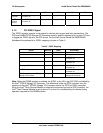
Intel® Server Board Set SE8500HW4 I/O Subsystems
Revision 1.0
Intel order number D22893-001
17
3.3 Intel® RAID On Motherboard (ROMB)
The Intel
®
IOP332 Storage I/O Processor, in conjunction with the LSI Logic 53C1030, provides
an optional RAID On Motherboard (ROMB) solution which supports RAID levels 0, 1, 5, 10, and
50. A 2MB flash component and a non-volatile SRAM store the code and hardware
configuration information.
To activate the ROMB solution, a physical Intel
®
RAID Activation Key (RAK) and DDR2 400MHz
RAID DIMM must be installed on the Intel
®
Server Board Set SE8500HW4 Mainboard. The RAK
contains a registration code required to unlock the LSI Mega RAID* solution. The DDR2
400MHz RAID DIMM serves as memory for the Intel
®
IOP332 Storage I/O Processor and a disk
cache to store write data for the drives. In addition to these components an Intel
®
RAID Smart
Battery (RSB) may also be installed to refresh the RAID DIMM when system power drops below
specifications.
After installing a RAK and DDR2 400MHz RAID DIMM, and optional RSB, the system BIOS
setup allows the user to enable the ROMB solution. During option ROM scan, an option to
configure the RAID is displayed. The following three chapters provide an overview of the Intel
ROMB solution, however, for more information refer to the Intel
®
RAID Smart Battery Technical
Product Specification.
3.3.1 Intel
®
RAID Activation Key (RAK)
The RAK is a round one-wire serial EEPROM device programmed by Intel. This key has a
registration code required to enable the LSI Mega RAID* solution.
3.3.2 DDR2 RAID DIMM
The ROMB solution only supports 400MHz registered ECC, with a CAS latency of four clock
cycles. Please refer to the Intel
®
Server Board SE8500HW4 Memory Qualification List for
supported memory.
3.3.3 Intel
®
RAID Smart Battery (RSB)
The RSB keeps the contents of the DDR2 400MHz RAID DIMM preserved if power drops below
specifications. When the Intel
®
IOP332 Storage I/O Processor senses power has dropped below
specifications, it initiates a power fail sequence that safely puts the RAID DIMM into self-refresh
state. The power subsystem generates enough of a delay to allow the Intel
®
IOP332 Storage I/O
Processor to complete its power fail sequence, even in the event of total system power loss.
After the power fail sequence is completed, additional logic keeps the RAID DIMM in self-
refresh mode. When power is restored, data from the RAID DIMM is safely written to the disk
array.


















